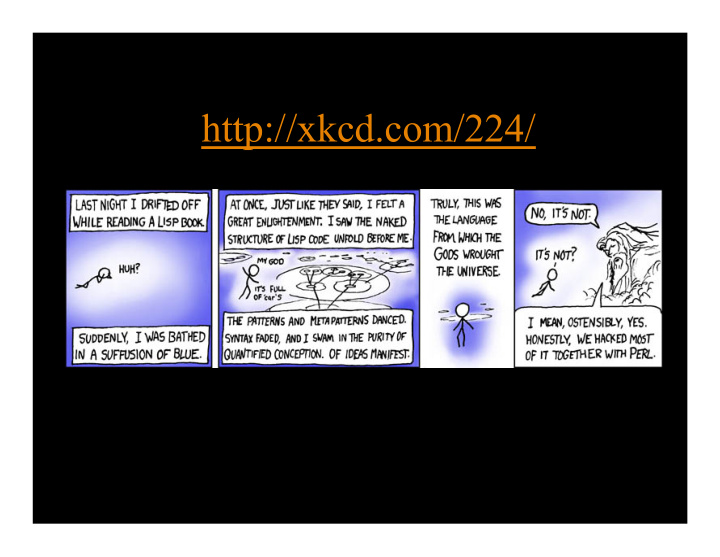



http://xkcd.com/224/
CS 152: Programming Language Paradigms Prof. Tom Austin San José State University
What are some programming languages?
Taken from http://pypl.github.io/PYPL.html January 2016
Why are there so many?
Different domains
Different design choices • Flexibility • Type safety • Performance • Build time • Concurrency
Which language is better?
Good language features • Simplicity • Readability • Learn-ability • Safety • Machine independence • Efficiency
These goals almost always conflict
Conflict: Type Systems Stop "bad" programs … but ... restrict the programmer
Why do we make you take a programming languages course? • You might use one of these languages. • Perhaps one of these languages is the language of the future (whatever that means). • You might see similar languages in your job. • Somebody made us take one, so now we want to make you suffer too. • But most of all…
We want to warp your minds.
Course goal: change the way that you think about programming. That will make you a better Java programmer.
The "Blub" paradox Why do I need higher order functions? My language doesn't have them, and it works just fine!!!
"As long as our hypothetical Blub programmer is looking down the power continuum, he knows he's looking down… [Blub programmers are] satisfied with whatever language they happen to use, because it dictates the way they think about programs." --Paul Graham http://www.paulgraham.com/avg.html
So what kind of abstractions do different languages give us?
Data Abstractions • Representation of common data values • Variables to represent memory locations. • Structures: arrays, text files, etc. • Organizational units: – APIs – packages – classes
Control Abstractions • "Syntactic sugar" x+=10 => x=x+10 • Branch instructions – if statements – while loops
A little history WWII: programming meant plugboards
Von Neumann (late 1940s) created a permanently hardwired general purpose instruction set. A small, machine language program
Assembly (1950s) • Translates mnemonic symbols to machine instructions. • Not a higher level – just easier for humans to read. mov ax, 1234h mov bx, ax
Higher-level languages • Fortran (1950s): – Algebraic notation, floating point math • Algol (1960): – Machine independence (via compiler) – Control structures: loops, procedures, if statements – Formal specification
Does a formal specification matter?
Languages we will cover (subject to change)
Administrative Details • Green sheet: http://www.cs.sjsu.edu/~austin/cs152-fall16/ Greensheet.html. • Homework submitted through Canvas: https://sjsu.instructure.com/ • Academic integrity policy: http://info.sjsu.edu/static/catalog/integrity.html
Schedule • The class schedule is available through Canvas • Late homeworks will not be accepted • Check the schedule before every class • Check the schedule before every class • And finally, CHECK THE SCHEDULE BEFORE EVERY CLASS.
Prerequisites • CS 151 or CMPE 135 , grade C- or better • Show me proof – If you don't, I will drop you.
Resources Dorai Sitaram "Teach Yourself Scheme in Fixnum Days". http://ds26gte.github.io/tyscheme/ Other references TBD.
Grading • 30% -- Homework assignments (individual work) • 20% -- Class project (team work) • 20% -- Midterm • 20% -- Final • 10% -- Participation (labs and drills)
Participation: Labs & Drills • Complete/incomplete • No feedback given (usually) • I will look at them • If you have questions, ask me
Homework • Done individually . • You may discuss the assignment with others. • Do your own work!
How to fail yourself and your friend If two of you turn in similar assignments: you both get a 0
Project • Work in groups of up to four people. • Goal: Build an interpreter. • Use Java and ANTLR
Office hours • MacQuarrie Hall room 216 • Mondays, noon-1pm • Thursdays, 11am-noon
Racket/ Scheme
What is Scheme? • A functional language – Describe what things are, not how to do them. – More mathematical compared to imperative langs. • A dialect of Lisp ( Lis t P rocessing) • (Famously) minimal language • Racket is a dialect of Scheme
Symbolic Expressions (s-expressions) The single datatype in Scheme. Includes: • Primitive types: booleans, numbers, characters, and symbols . • Compound data types: strings, vectors, pairs, and of course… LISTS!!!
A bit of scheming • Sample list: '(1 2 3 4) – The quote declares this list as data • First argument is assumed to be a function – Rest of the list are its arguments – (* 4 3 2 1) • car : gets the first element of the list • cdr : gets the tail of the list.
$ racket Welcome to Racket v6.0.1. > '(1 2 3 4) Quote indicates list '(1 2 3 4) is data > (car '(1 2 3 4)) 1 First element is assumed to be a > (cdr '(1 2 3 4)) function '(2 3 4) > (+ 1 (* 2 4) (- 5 1)) 13 >
Before next class • Install Racket from http://racket-lang.org/ • Read chapters 1-2 of Teach Yourself Scheme . • Read Paul Graham's "Beating the Averages" article. http://www.paulgraham.com/avg.html
First homework due September 8th • This assignment is designed to get you up and running with Racket. • Available in Canvas. – If you don't have access to Canvas, see http://www.cs.sjsu.edu/~austin/cs152- fall16/hw/hw1/ instead. • Get started now!
Recommend
More recommend